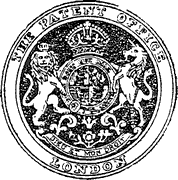|
|
|
|||
|
|
||||
|
|
||||
| ARCHIVE: Patent 907,218 | ||||
|
|
HOME | SITE MAP | FORUM | CONTACT |
|
||
|
ABOUT | MOTORS | MODELS | ARCHIVE | HISTORY | STORE | FAQ | LINKS
|
|
|
|
|
|
|||
|
PATENT SPECIFICATION 907,218
Inventors: CECIL ARTHUR RASSIER and JOSEPH NAIME MANSOUR. |
||||
|
Date of filing Complete Specification: Aug. 24, 1959. Application Date: Aug. 25, 1958. No. 27258/58. Complete Specification Published: Oct. 3, 1962.
COMPLETE SPECIFICATION
Improvements in or relating to Reaction Motors We, D. SEBEL & COMPANY LIMITED, of 177, West Street, Erith, Kent, a British Company, do hereby declare the invention, for which we pray that a patent may be granted to us, and the method by which it is to be performed, to be particularly described in and by the following statement:— |

|
|||
|
The present invention relates to small reaction motors of the rocket type suitable for use in a model aircraft or other vehicle or for other purposes. Such motors frequently comprise a casing of substantially cylindrical configuration closed at the front end and carrying at the rear end a cap secured thereto by a spring yoke or by screw threads or the like this motor being disclosed on Patent No. 642,689. This cap carries the jet orifice and when the motor is operating the joint between the cap and the casing motor is exposed to the high temperatures and corrosion effects of the burning gases. Since these motors are made as light as possible the wall of the casing is necessarily thin and from time to time if the joint between the cap and the casing is not properly made the gases leak between the cap and the casing. These burning gases escaping between the cap and the casing frequently cause the structure of the vehicle to be set alight and destroyed or at least cause burning of the casing. Furthermore since the cap overlies the casing forwardly directed gas jets are produced which have a breaking [sic] effect upon the plane or other vehicle. An object of the present invention is to provide a construction of motor which safeguards the vehicle from being burned and prevents such braking effect in the event of leaks taking place between the cap and the casing. According to the present invention there is provided a reaction motor of the type in which the jet orifice is carried in a cap detachably secured to the casing of the motor in which the propulsion gases are generated, wherein the cap has a lip which is engageable with the outer surface of the jet nozzle end of the case and wherein a flange which extends around the periphery of the casing is located at the jet orifice end of the casing the flange being directed rearwardly and adapted to overlie the lip of the cap so that the lip is located in the space formed between the flange and the outer face of the casing. Conveniently the flange is flared outwardly and rearwardly so as to provide a streamlined contour to minimise its resistance to the air. |
These burning gases escaping between the cap and the casing frequently cause the structure of the vehicle to be set alight and destroyed […] An object of the present invention is to provide a construction of motor which safeguards the vehicle from being burned
|
|||
|
|
|
|
|
|
|
|
Acknowledgements - Original patents located, copied and compiled by Gerhard Everwyn; contributed by Terry Kidd |
|
|
|
|
ABOUT | MOTORS | MODELS | ARCHIVE | HISTORY | STORE | FAQ | LINKS |
|
|
Terms of Use
|
Queries? Corrections? Additions?
Please
contact us.
|
|